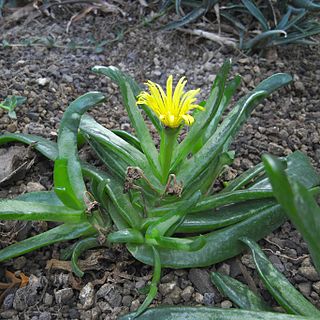| Gunniopsis calva | |
|---|---|
| Scientific classification | |
| Kingdom: | Plantae |
| (unranked): | Angiosperms |
| (unranked): | Eudicots |
| (unranked): | Core eudicots |
| Order: | Caryophyllales |
| Family: | Aizoaceae |
| Genus: | Gunniopsis |
| Species: | G. calva |
| Binomial name | |
| Gunniopsis calva Chinnock | |
Gunniopsis calva, commonly known as the smooth pigface, is a succulent plant in the iceplant family, Aizoaceae. It is endemic to Australia. [1]

In botany, succulent plants, also known as succulents, are plants that have some parts that are more than normally thickened and fleshy, usually to retain water in arid climates or soil conditions. The word "succulent" comes from the Latin word sucus, meaning juice, or sap. Succulent plants may store water in various structures, such as leaves and stems. Some definitions also include roots, thus geophytes that survive unfavorable periods by dying back to underground storage organs may be regarded as succulents. In horticultural use, the term "succulent" is sometimes used in a way which excludes plants that botanists would regard as succulents, such as cacti. Succulents are often grown as ornamental plants because of their striking and unusual appearance.

The AizoaceaeMartynov, nom. cons. is a large family of dicotyledonous flowering plants containing 135 genera and about 1800 species. They are commonly known as ice plants or carpet weeds. They are often called vygies in South Africa and New Zealand. Highly succulent species that resemble stones are sometimes called mesembs.

Australia, officially the Commonwealth of Australia, is a sovereign country comprising the mainland of the Australian continent, the island of Tasmania and numerous smaller islands. It is the largest country in Oceania and the world's sixth-largest country by total area. The neighbouring countries are Papua New Guinea, Indonesia and East Timor to the north; the Solomon Islands and Vanuatu to the north-east; and New Zealand to the south-east. The population of 25 million is highly urbanised and heavily concentrated on the eastern seaboard. Australia's capital is Canberra, and its largest city is Sydney. The country's other major metropolitan areas are Melbourne, Brisbane, Perth and Adelaide.
The annual herb is glabrous and typically grows to a height of 20 centimetres (7.9 in). It has striated and terete branchlets. The succulent yellow-green leaves are ovate or oblong in shape, approximately 32 mm (1.3 in) long and 10 mm (0.39 in) wide. It blooms between August and October producing small yellow solitary flowers. [1]
It is found around the margins of salt lakes in the area north of Port Augusta to central South Australia where it grows in sandy or clay soils. [1]

South Australia is a state in the southern central part of Australia. It covers some of the most arid parts of the country. With a total land area of 983,482 square kilometres (379,725 sq mi), it is the fourth-largest of Australia's states and territories by area, and fifth largest by population. It has a total of 1.7 million people, and its population is the second most highly centralised in Australia, after Western Australia, with more than 77 percent of South Australians living in the capital, Adelaide, or its environs. Other population centres in the state are relatively small; Mount Gambier, the second largest centre, has a population of 28,684.
The species was first formally described by Robert Chinnock in 1983 in the article The Australian genus Gunniopsis Pax (Aizoaceae) in the Journal of the Adelaide Botanic Gardens. [2]
Robert James "Bob" Chinnock is a New Zealand-born Australian botanist who worked at the State Herbarium of South Australia as a senior biologist. He retired in 2008 but still works as an honorary research associate.




